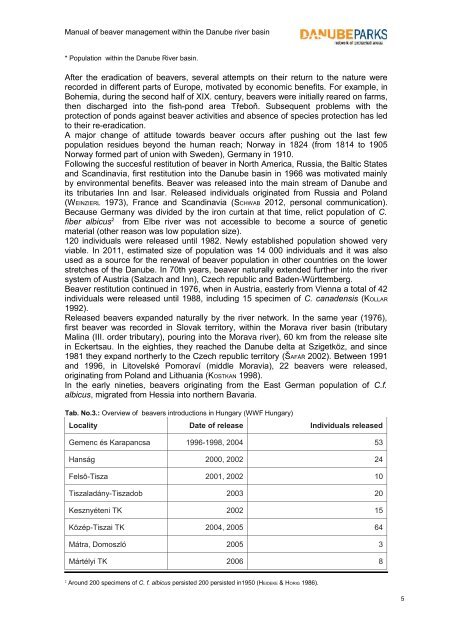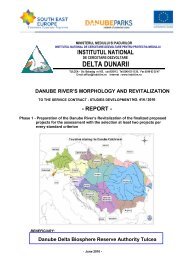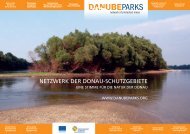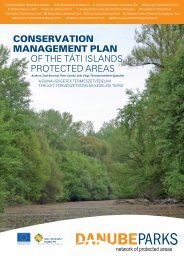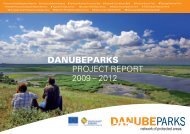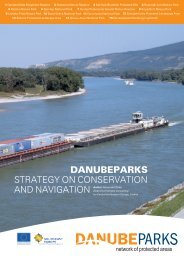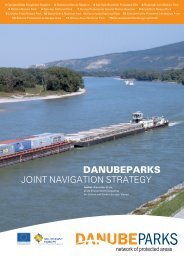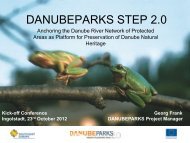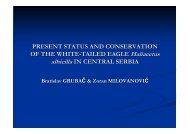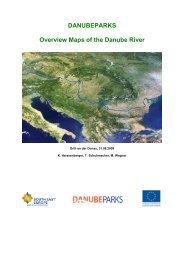Manual of beaver management within the ... - DANUBEPARKS
Manual of beaver management within the ... - DANUBEPARKS
Manual of beaver management within the ... - DANUBEPARKS
- No tags were found...
You also want an ePaper? Increase the reach of your titles
YUMPU automatically turns print PDFs into web optimized ePapers that Google loves.
<strong>Manual</strong> <strong>of</strong> <strong>beaver</strong> <strong>management</strong> <strong>within</strong> <strong>the</strong> Danube river basin* Population <strong>within</strong> <strong>the</strong> Danube River basin.After <strong>the</strong> eradication <strong>of</strong> <strong>beaver</strong>s, several attempts on <strong>the</strong>ir return to <strong>the</strong> nature wererecorded in different parts <strong>of</strong> Europe, motivated by economic benefits. For example, inBohemia, during <strong>the</strong> second half <strong>of</strong> XIX. century, <strong>beaver</strong>s were initially reared on farms,<strong>the</strong>n discharged into <strong>the</strong> fish-pond area Třeboň. Subsequent problems with <strong>the</strong>protection <strong>of</strong> ponds against <strong>beaver</strong> activities and absence <strong>of</strong> species protection has ledto <strong>the</strong>ir re-eradication.A major change <strong>of</strong> attitude towards <strong>beaver</strong> occurs after pushing out <strong>the</strong> last fewpopulation residues beyond <strong>the</strong> human reach; Norway in 1824 (from 1814 to 1905Norway formed part <strong>of</strong> union with Sweden), Germany in 1910.Following <strong>the</strong> succesful restitution <strong>of</strong> <strong>beaver</strong> in North America, Russia, <strong>the</strong> Baltic Statesand Scandinavia, first restitution into <strong>the</strong> Danube basin in 1966 was motivated mainlyby environmental benefits. Beaver was released into <strong>the</strong> main stream <strong>of</strong> Danube andits tributaries Inn and Isar. Released individuals originated from Russia and Poland(WEINZIERL 1973), France and Scandinavia (SCHWAB 2012, personal communication).Because Germany was divided by <strong>the</strong> iron curtain at that time, relict population <strong>of</strong> C.fiber albicus 2 from Elbe river was not accessible to become a source <strong>of</strong> geneticmaterial (o<strong>the</strong>r reason was low population size).120 individuals were released until 1982. Newly established population showed veryviable. In 2011, estimated size <strong>of</strong> population was 14 000 individuals and it was alsoused as a source for <strong>the</strong> renewal <strong>of</strong> <strong>beaver</strong> population in o<strong>the</strong>r countries on <strong>the</strong> lowerstretches <strong>of</strong> <strong>the</strong> Danube. In 70th years, <strong>beaver</strong> naturally extended fur<strong>the</strong>r into <strong>the</strong> riversystem <strong>of</strong> Austria (Salzach and Inn), Czech republic and Baden-Württemberg.Beaver restitution continued in 1976, when in Austria, easterly from Vienna a total <strong>of</strong> 42individuals were released until 1988, including 15 specimen <strong>of</strong> C. canadensis (KOLLAR1992).Released <strong>beaver</strong>s expanded naturally by <strong>the</strong> river network. In <strong>the</strong> same year (1976),first <strong>beaver</strong> was recorded in Slovak territory, <strong>within</strong> <strong>the</strong> Morava river basin (tributaryMalina (III. order tributary), pouring into <strong>the</strong> Morava river), 60 km from <strong>the</strong> release sitein Eckertsau. In <strong>the</strong> eighties, <strong>the</strong>y reached <strong>the</strong> Danube delta at Szigetköz, and since1981 <strong>the</strong>y expand nor<strong>the</strong>rly to <strong>the</strong> Czech republic territory (ŠAFÁŘ 2002). Between 1991and 1996, in Litovelské Pomoraví (middle Moravia), 22 <strong>beaver</strong>s were released,originating from Poland and Lithuania (KOSTKAN 1998).In <strong>the</strong> early nineties, <strong>beaver</strong>s originating from <strong>the</strong> East German population <strong>of</strong> C.f.albicus, migrated from Hessia into nor<strong>the</strong>rn Bavaria.Tab. No.3.: Overview <strong>of</strong> <strong>beaver</strong>s introductions in Hungary (WWF Hungary)Locality Date <strong>of</strong> release Individuals releasedGemenc és Karapancsa 1996-1998, 2004 53Hanság 2000, 2002 24Felsô-Tisza 2001, 2002 10Tiszaladány-Tiszadob 2003 20Kesznyéteni TK 2002 15Közép-Tiszai TK 2004, 2005 64Mátra, Domoszló 2005 3Mártélyi TK 2006 82Around 200 specimens <strong>of</strong> C. f. albicus persisted 200 persisted in1950 (HEIDEKE & HORIG 1986).5


